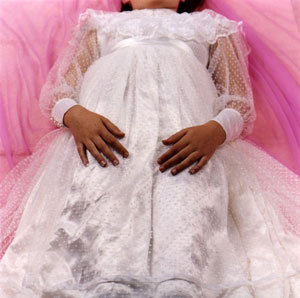
Sweet Lullaby
Rainbow Days
A surfeit of the feminine suffuses Deborah Paauwe's world, in which an exploration/illumination of female sexuality and desire is intensified through a layering of feminine signifiers - hand-worked lace and embroidery, a high-heeled shoe, a lush cascade of hair. Emerging from the diaphanous veiling, the obfuscation of Double Dutch (2002), the images of Rainbow Days spill forth in an array of saturated colour.
Much is and remains ambiguous in Paauwe's oeuvre, yet with the Sapphic intimations of Tuesday's Child (2001) and Double Dutch a fuller, though not necessarily linear narrative is beginning to develop. A continuing strain of compliant passivity and presentation can be traced from the pivotal Bedtime Story (1998), to Silent Sleeping Beauty of the Sugar Nights (2000) series and Sweet Lullaby from the current body of work. The glacial whiteness of the silk and lace confirmation gown - cloyingly sweet against its candy pink background - bestows on the image not only a quality of the ceremonial, but also a potent sense of anticipation. Verging at times on the sepulchral, this solitary inertia is counterpointed by palpable signs of activity and increasingly bold interactivity. Thus the early scene of a girlishly innocent figure adjusting the hair ribbon of her friend, has made way for the intertwining naked limbs of Double Dutch and Lime Dream's more subtle overture of two caressing hands, a straying fragment of green tulle onto a bare leg
Peeling an orange, presenting an attitude of invocation, clasping a lollipop; in Paauwe's vignettes of faceless, cropped bodies, hands have from the outset assumed a studied prominence, reflective of the fluctuating moods. In Milk and Kisses they are self-consciously and theatrically arranged, with a taut dancer's awareness of body tone that extends to the fingertips.
Five Star revisits a previous, polished Lolita-like landscape, but it is an altogether more dishevelled representation. The hair hangs in vaguely threatening, tousled strands around a bare torso, the wand aggressively dominating the foreground of the frame with an uncharacteristic and almost jarring harshness - absent for example in the more demure delicacy of Porcelain (2002). In the curious world of competitive ballroom dancing, one can observe the mimetic skill with which children - performing the sensual movements of the rumba for example - are able to outwardly approximate adult emotions and sexual expression. Like Pink Fire, Milk and Kisses - in which the female subject is pictured in an over-large flock nylon dress - gives literal expression to this experimentation with an adult persona. Such role playing can be viewed as innocently playful, but also has its inherent dangers and it is this complex period of transition between girlhood and adulthood, with its concomitant and contrary associations of good child/bad child, which preoccupies Paauwe.
The occasional, albeit anonymous appearance in her own photographs lends weight to the assumption that childhood memories/experiences and their reconstruction, underpin Paauwe's narrative. Is there also a sense of yearning implicit in these images, a reimagining, a revisualisation of the past? Double Crush with its visual jolt of columns of black hair against preposterously white skin, reiterates the mother and child leitmotif of Playground from the Double Dutch series. Invariably attired in a vintage frock, the figure of the mother is an enduringly significant, hovering presence. Is it possible that Paauwe is simultaneously constructing an enhanced, a more glamorous history for the mother figure - a woman who wears long satin gloves, beautiful dresses, goes out dancing?
As Paauwe teases and provokes, reveals and withholds and above all thwarts, without even momentarily relinquishing control, an element of mystery continues to prevail. Gazing at this rainbow of images we see not the reflection and refraction of the rays of the sun, but rather a reflection of ourselves. It is this confrontation that exists as Paauwe's ultimate challenge.
© Wendy Walker 2002